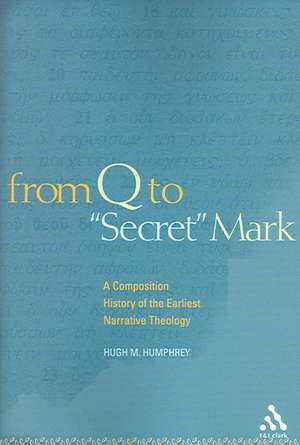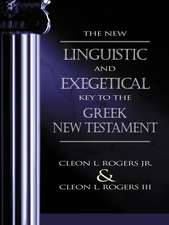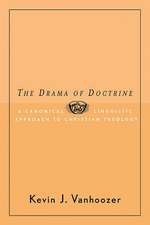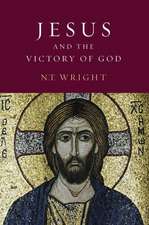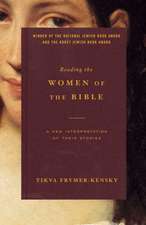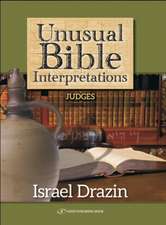From Q to "Secret" Mark: A Composition History of the Earliest Narrative Theology
Autor Hugh M. Humphreyen Limba Engleză Paperback – 31 mai 2006
| Toate formatele și edițiile | Preț | Express |
|---|---|---|
| Paperback (1) | 177.67 lei 6-8 săpt. | |
| Bloomsbury Publishing – 31 mai 2006 | 177.67 lei 6-8 săpt. | |
| Hardback (1) | 888.81 lei 6-8 săpt. | |
| Bloomsbury Publishing – 31 mai 2006 | 888.81 lei 6-8 săpt. |
Preț: 177.67 lei
Preț vechi: 231.89 lei
-23% Nou
Puncte Express: 267
Preț estimativ în valută:
33.100€ • 35.59$ • 28.30£
33.100€ • 35.59$ • 28.30£
Carte tipărită la comandă
Livrare economică 31 martie-14 aprilie
Preluare comenzi: 021 569.72.76
Specificații
ISBN-13: 9780567025128
ISBN-10: 0567025128
Pagini: 176
Dimensiuni: 154 x 228 x 11 mm
Greutate: 0.29 kg
Editura: Bloomsbury Publishing
Colecția T&T Clark
Locul publicării:New York, United States
ISBN-10: 0567025128
Pagini: 176
Dimensiuni: 154 x 228 x 11 mm
Greutate: 0.29 kg
Editura: Bloomsbury Publishing
Colecția T&T Clark
Locul publicării:New York, United States
Caracteristici
Challenges the traditional view that Mark was simply an editor of drawing on difference sources to put his gospel together.
Recenzii
"Hugh M. Humphrey writes with freshness and panache..."
"The argument is lucid, internally coherent and succinct." F. Gerald Downing JSNTS Booklist, 2007
Review in The Journal of Theological Studies, Vol 59, no 1, April 2008
Humphrey says Mark first compiled Peter's preaching of the Q material, expanding it into a narrative (chapters one to thirteen) portraying Jesus as the Son of God inspired by Wisdom, the eschatological Teacher. This he did while Peter was preaching in Rome. Later he narrated Peter's preaching of the cross, creating the Passion Narrative. It was "Pauline" in its Christology of a self-emptying Son of Man/Adam. This was on the eve of Claudius's expulsion of Jews from Rome. Taking both texts to Alexandria, Mark decided to unite the two texts, seeding each half with new materials recalling or foreshadowing the other, adding the theme of discipleship in a world not likely to end as soon as he had first expected... Markan specialists should be sure to read it. Robert M. Price Johnnie Colemon Theological Seminary
"The argument is lucid, internally coherent and succinct." F. Gerald Downing JSNTS Booklist, 2007
Review in The Journal of Theological Studies, Vol 59, no 1, April 2008
Humphrey says Mark first compiled Peter's preaching of the Q material, expanding it into a narrative (chapters one to thirteen) portraying Jesus as the Son of God inspired by Wisdom, the eschatological Teacher. This he did while Peter was preaching in Rome. Later he narrated Peter's preaching of the cross, creating the Passion Narrative. It was "Pauline" in its Christology of a self-emptying Son of Man/Adam. This was on the eve of Claudius's expulsion of Jews from Rome. Taking both texts to Alexandria, Mark decided to unite the two texts, seeding each half with new materials recalling or foreshadowing the other, adding the theme of discipleship in a world not likely to end as soon as he had first expected... Markan specialists should be sure to read it. Robert M. Price Johnnie Colemon Theological Seminary
Descriere
Humphrey challenges traditional readings of Mark and Q by arguing that Q had a narrative layer that mark incorporated in his gospel.
Cuprins
Introduction
ChapterOne: Revisiting the Fathers
I. The Witness of the Early Church Fathers
A. Papias
B. Clement of Alexandria
C. Recap of Papias and Clement
D. Conflicting Testimony?
1. Anti-Marcionite Prologue
2. Irenaeus
E. The Eyptian Connection
1. Eusebius
2. Jerome
3. Clement of Alexandria and the "SecretGospel"
4. The Venetian Tradition
II. The (Patristic) History of the Composition of Mark
ChapterTwo: A Narrative Version of "Q"
I. Introduction
A. The Textual Parallels between Mark and Q
B. The Narrative Parallels between Mark and Q
C. A Distinctive Narrative Feature of Mark'sVersion of Q:
Jesus is the "Holy Son of God"
D. The Distinctive Vocabulary of QN
E. Summary of the Characteristic Features of QNin Mark
F. Preliminary Suggestions About the Provenanceof QN
II. Mark's Narrative Version of Q
III. The Community Reflected by Mark's Narrative Version of Q
ChapterThree: The Passion Narrative inMark
I. Introduction
A. A Second Christology Reflected in Mark
B. The Characteristic Features of Mark 14:1 -16:8
C. Secondary Materials in Mark 14:1 - 16:8
II. The Earlier Text of Mark 14:1 - 16:8
III. The Community Reflected by Mark'sEarlier Passion Narrative
ChapterFour: Assimilation and a Focus on Discipleship
I. Putting Mark's Gospel Together
II. The Community Reflected by These Additions to the Text of Mark
ChapterFive: The Composition History of the Gospel of Mark 176
I. Introduction. The Gathering ofthe Pieces
II. The Explanatory Glosses. Creating our Present Text of the Gospel
III. A Reflection of "Mark, the Evangelist"
Table:Summarizing the Composition History of the Gospel of Mark ---
Appendix1: The Mark without Q Hypothesis 188
Appendix2: Assessing the Quest for a Proto-Mark 196
WorksCited 205
Appendix 3: The Stages of theComposition of Mark illustrated
ChapterOne: Revisiting the Fathers
I. The Witness of the Early Church Fathers
A. Papias
B. Clement of Alexandria
C. Recap of Papias and Clement
D. Conflicting Testimony?
1. Anti-Marcionite Prologue
2. Irenaeus
E. The Eyptian Connection
1. Eusebius
2. Jerome
3. Clement of Alexandria and the "SecretGospel"
4. The Venetian Tradition
II. The (Patristic) History of the Composition of Mark
ChapterTwo: A Narrative Version of "Q"
I. Introduction
A. The Textual Parallels between Mark and Q
B. The Narrative Parallels between Mark and Q
C. A Distinctive Narrative Feature of Mark'sVersion of Q:
Jesus is the "Holy Son of God"
D. The Distinctive Vocabulary of QN
E. Summary of the Characteristic Features of QNin Mark
F. Preliminary Suggestions About the Provenanceof QN
II. Mark's Narrative Version of Q
III. The Community Reflected by Mark's Narrative Version of Q
ChapterThree: The Passion Narrative inMark
I. Introduction
A. A Second Christology Reflected in Mark
B. The Characteristic Features of Mark 14:1 -16:8
C. Secondary Materials in Mark 14:1 - 16:8
II. The Earlier Text of Mark 14:1 - 16:8
III. The Community Reflected by Mark'sEarlier Passion Narrative
ChapterFour: Assimilation and a Focus on Discipleship
I. Putting Mark's Gospel Together
II. The Community Reflected by These Additions to the Text of Mark
ChapterFive: The Composition History of the Gospel of Mark 176
I. Introduction. The Gathering ofthe Pieces
II. The Explanatory Glosses. Creating our Present Text of the Gospel
III. A Reflection of "Mark, the Evangelist"
Table:Summarizing the Composition History of the Gospel of Mark ---
Appendix1: The Mark without Q Hypothesis 188
Appendix2: Assessing the Quest for a Proto-Mark 196
WorksCited 205
Appendix 3: The Stages of theComposition of Mark illustrated
